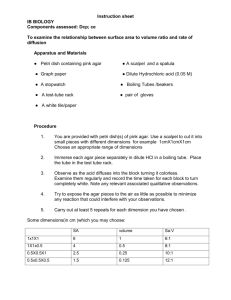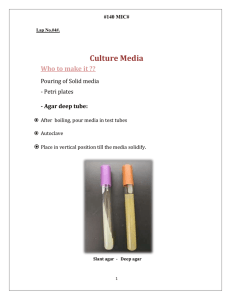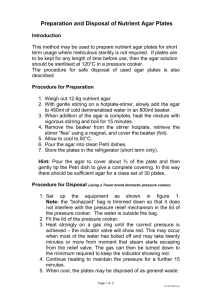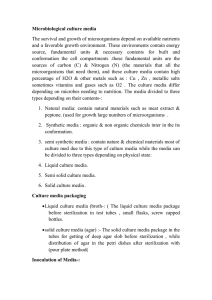CULTURING MICROBES: GENERAL POINTS Biotechnology Protocols
advertisement
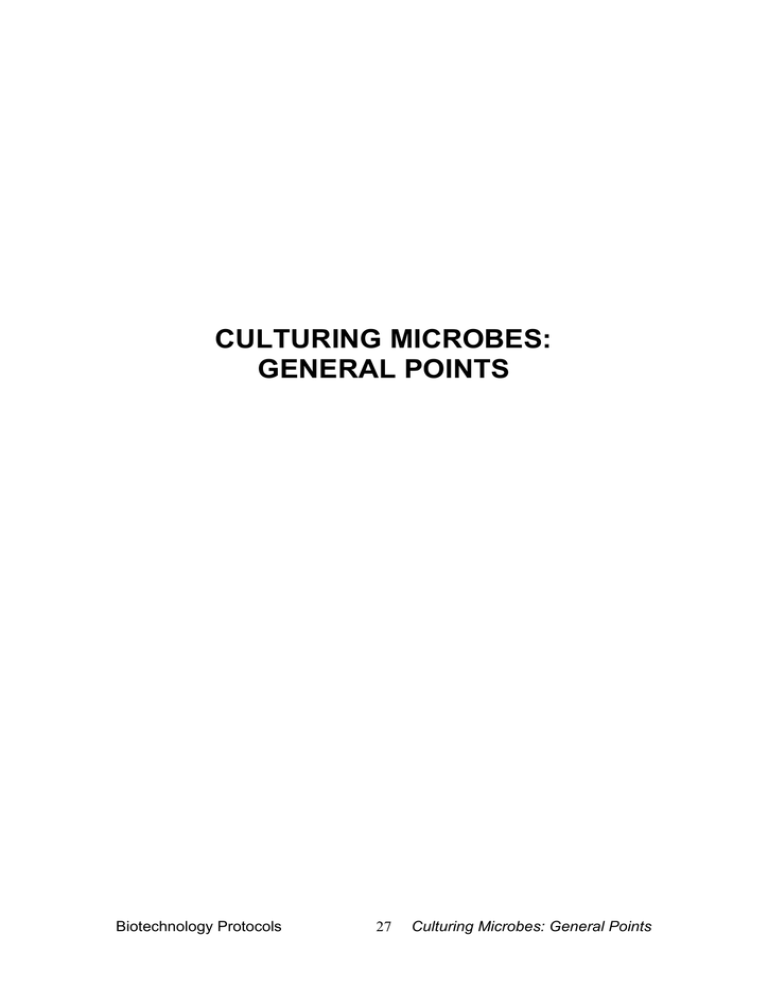
CULTURING MICROBES: GENERAL POINTS Biotechnology Protocols 27 Culturing Microbes: General Points CULTURE TECHNIQUES Source: HSDU Biology and Biotechnology Microbiological Techniques (Intermediate 1-Advance Higher) Folder GENERAL TIPS All work should be completed where possible within a nine inch radius of the bunsen burner (on a blue flame). This is because the updraft of hot air carries micro-organisms away from the experiment (i.e. reduces contamination problems) as well as carrying them away from you (i.e. reduces health & safety risks). Label all tubes, bottles, plates etc. before commencing inoculation. Loosen all screw-caps beforehand so that it requires only one half-turn to remove cap. Make a habit of flaming the loop as soon as you take it up and immediately before you put it down, even if you don’t use it. Similarly, you should flame the necks of all bottles when you open and when you close them. Biotechnology Protocols 28 Culturing Microbes: General Points PREPARATION OF SELF AND WORKSPACE Source: HSDU Biology and Biotechnology Microbiological Techniques (Intermediate 1-Advance Higher) Folder Materials Benchkote and non-absorbent tape if required Disinfectant and paper towel Discard jar with disinfectant Bunsen burner Wire loop/inoculating instrument Cultures and media Instructions The following applies to right-handed operators. Left-handed people should reverse the arrangement on the bench. 1 Tie back long hair. 2 Wash and dry hands thoroughly. 3 Cover any cuts/grazes with waterproof plaster. 4 Put on lab coat. 5 Collect materials. 6 Attach benchkote to the bench if necessary using sticky tape. 7 Swab the surface of your work space with 1% hypochlorite or 1% bleach using the paper towel. Discard paper towel. 8 Keep workspace clear of non-essential items. 9 Place the wire loop/inoculating implement to the right of the bench so that you can reach it with ease. 10 Place the Bunsen burner centrally so that you can reach it with ease but not so close that you are likely to burn yourself. 11 Place cultures and media to the left but still within easy reach. Place discard jar containing clear phenolic disinfectant such as Stericol to the right within easy reach. The bench must be set up in this way (see diagram on page 30) each time a microbiology practical is carried out. Biotechnology Protocols 29 Culturing Microbes: General Points Source: HSDU Biology and Biotechnology Microbiological Techniques (Intermediate 1-Advance Higher) Folder Basic layout of work space: Biotechnology Protocols 30 Culturing Microbes: General Points FLAMING A LOOP Source: HSDU Biology and Biotechnology Microbiological Techniques (Intermediate 1-Advance Higher) Folder Loops are used to transfer microbes from one growth medium/vessel to another. Metal (nichrome) loops have the advantage over plastic loops in that they can be re-used, but they must be sterilised before every application. Sterilisation is achieved using heat, as detailed here. Biotechnology Protocols 31 Culturing Microbes: General Points FLAMING WITH ALCOHOL Source: HSDU Biology and Biotechnology Microbiological Techniques (Intermediate 1-Advance Higher) Folder Materials Implement – spreader, forceps or mounted needle 20 ml alcohol in closed bottle Shallow glass dish such as Petri dish with glass or fireproof cover Instructions 1 Pour alcohol into shallow glass dish. 2 Dip implement in alcohol and shake off excess. 3 Place lid over alcohol. 4 Place implement in flame to allow alcohol to catch fire. 5 Remove implement from flame and allow alcohol to burn off. Do not put the implement down on bench. 6 Carry out the procedure using the implement. 7 Repeat steps 2 – 5. Place implement on heat resistant mat. Biotechnology Protocols 32 Culturing Microbes: General Points FLAMING A NECK Source: HSDU Biology and Biotechnology Microbiological Techniques (Intermediate 1-Advance Higher) Folder The necks of all bottles, flasks and test tubes should be flamed before and after opening to reduce the chance of contaminants entering the vessel. This is done by the process shown in the following diagram: Biotechnology Protocols 33 Culturing Microbes: General Points TREATMENT OF SPILLAGES Source: HSDU Biology and Biotechnology Microbiological Techniques (Intermediate 1-Advance Higher) Folder Spillage Kit Contents Disposable plastic gloves Undiluted clear phenolic disinfectant (e.g. Stericol, Hycolin, Clearsil) or Virkon in a bottle marked with a dilution line Disposable cloths or paper towels for soaking with disinfectant and applying to spill A small plastic dustpan and paper towels Autoclavable plastic tongs An autoclavable waste disposal bag To deal with a small scale spill 1 Wear a lab coat, disposable plastic gloves and use eye protection. 2 Cover spillage with paper towels. 3 Dilute the disinfectant to the recommended concentration (see manufacturers guidelines for specific disinfectants and also the Code of Practice detailed on p8 of these notes). 4 Pour a ring of freshly made disinfectant around the spill and over the paper towels covering the spill. 5 Leave for at least ten minutes. 6 Using paper towels, sweep the debris on to the plastic dustpan. 7 Using tongs if necessary, place the debris into an autoclavable disposal bag (broken glass should be placed in a separate solid autoclavable container or 'double-bagged'). 8 Autoclave the debris. 9 Place in a bin bag and dispose of with domestic waste. 10 Autoclave the dustpan and tongs. If not autoclave safe, immerse in clear phenolic disinfectant for at least 24 hours. Biotechnology Protocols 34 Culturing Microbes: General Points STERILISATION USING A PRESSURE COOKER / AUTOCLAVE Source: HSDU Biology and Biotechnology Microbiological Techniques (Intermediate 1-Advance Higher) Folder Materials Protective gloves Pressure cooker/autoclave Water Materials to be sterilised Method 1 Wear a lab coat and use eye protection. Wear protective gloves when handling hot equipment. 2 Add water to the recommended depth (3 cm) to the base of the pressure cooker. 3 Place the trivet/stand in the base if required. 4 Loosen caps slightly (tighten then loosen a quarter turn) on bottles and place the materials to be sterilised in cooker/autoclave. Note that bottles should contain a maximum of 500 cm3 of medium and there should be space for expansion above the medium in the bottle. 5 Place Browne’s tube/spore strip as close as possible to centre of materials to be sterilised. 6 Secure the lid of the pressure cooker/autoclave according to the manufacturer’s instructions. 7 Heat on an electric or gas ring till steam issues evenly or switch on if the heater is integral. 8 Place on the valve (pressure cooker and some autoclaves). 9 When cooker begins to ‘hiss’ evenly, turn down heat. 10 Continue heating gently for 15 minutes. Note that steam should continue to issue gently from the valve – if it does not, pressure and temperature are likely to have fallen. 11 Turn off heat and allow to cool. Do not attempt to speed up cooling – this can distort the pressure cooker and can cause media to boil over. 12 Take care when opening lid that steam does not issue towards the operator. 13 Allow sterilised materials to cool before removing from the vessel. Biotechnology Protocols 35 Culturing Microbes: General Points AGAR PLATES Source: NQ Curriculum Support Intermediate 2 Biotechnology (Unit 2 Student Materials) Micro-organisms are grown in or on a culture medium containing all the required nutrients for growth. Culture media can be liquid or solid. Liquid or broth media although convenient have some disadvantages. Growths usually do not exhibit characteristic appearances in them and, except when they are designed for a specific biochemical test, they are of limited use in identifying species. Also, contaminating organisms cannot be seen readily in liquid media and liquid media are more difficult to handle in ways which avoid formation of aerosols. On solid media, micro-organisms grow to form discrete colonies. Each colony is a clone of cells originating from a single organism and represents the growth of a single species. Micro-organisms can be identified by the appearance exhibited by the different colonies. Bacterial colonies on a nutrient agar plate Biotechnology Protocols 36 Culturing Microbes: General Points Agar Liquid media can be made solid by the addition of agar. Agar has no nutritional value nor does it inhibit growth, it is simply a solidifying agent. The melting and solidifying points of agar are not the same. At the concentrations normally used, most agars melt at about 95C when heated but solidify only when cooled to about 42C. This low solidifying point allows heat-sensitive nutrients to be mixed with molten agar at temperatures as low as 45C before pouring. The high melting point ensures that the medium remains solid at all laboratory incubation temperatures. MAKING NUTRIENT AGAR (always check individual suppliers instructions for quantities to use) Weigh out 2 g agar powder (use masks) Dissolve in 100 ml distilled water whilst stirring Heat until boiling (stir continuously) Remove heat Leave to cool i.e. until you can pick up the beaker NOT until the agar sets Pour into labelled ‘medical flats’ i.e. flat-sided glass bottles Put the tops on – NOT fully tightened AUTOCLAVE the bottles of agar at 1210C for 15 minutes i.e. high TEMPERATURE and PRESSURE . Allow to cool to 550C before pouring. Pouring Agar Plates Agar plates are prepared by pouring liquid agar at 55C into sterile Petri dishes and allowing it to solidify. Before pouring, unopened plates are labelled on the underside using an indelible pen or wax pencil with initials, date and type of agar. This prevents Biotechnology Protocols 37 Culturing Microbes: General Points confusion should lids inadvertently be swapped. The plates are then placed the right way up prior to pouring of molten agar. If sterile agar in universal bottles or other containers has cooled and solidified, then it must be melted by heating to 100C then cooled in a water bath to 55C. Using aseptic technique, a bottle neck is flamed and the agar poured gently into a Petri dish on a flat surface, raising the lid of the dish only far enough for the mouth of the bottle to enter. About 15mls of molten agar is poured into each Petri dish. The lid is then replaced and the plate left undisturbed until the agar has cooled and set. It is essential that the surface of the medium should be dry in order to maintain single colonies. Condensation produced from the cooling of the agar can make the agar surface wet but is normally reduced by pouring the agar when it is at 55C. The agar will still be molten so must set before the plates can be inverted, however if condensation is still an issue then the plates can be dried open and upside down in an undisturbed area. Any plates showing lumps, bubbles or growth should be discarded. Acceptable plates should be stored upside down until required. Plates are always incubated and stored in the inverted position to prevent condensation dropping on the agar surface. Biotechnology Protocols 38 Culturing Microbes: General Points POURING PLATES Source: NQ Curriculum Support Intermediate 2 Biotechnology (Unit 2 Student Materials) Materials Universals or bottles containing larger volumes* of sterile molten nutrient agar (at 55C) Sterile plastic Petri dishes Bunsen burner Instructions This method is written for right-handed people. If you are left handed, please reverse handling instructions. 1 Wear a lab coat and use eye protection. 2 Label the empty sterile Petri dishes on the base with name, date and type of agar. (N.B. if the lid comes off, the plate is no longer sterile and you must discard it). 3 Light the Bunsen burner. 4 Collect one bottle of sterile molten agar from the water bath. Check it is not too hot nor that it has not started to solidify. 5 Place a Petri dish right way up on the bench. 6 Check that the top of the bottle of agar is loose. 7 Hold the bottle of agar in the left hand. 8 Unscrew and remove the cap of the bottle with the little finger of the right hand. 9 Flame the neck of the bottle. 10 With the right hand lift the lid of the Petri dish a little and gently pour in the molten agar. 11 Replace the lid of the Petri dish. 12 Flame neck and then replace the cap of the bottle and put it down. 13 Swirl the plate very gently to distribute the agar evenly. (N.B. The base of the plate must be covered, agar must not touch the lid of the plate and the surface must be smooth with no bubbles). Biotechnology Protocols 39 Culturing Microbes: General Points 14 Repeat for the other bottles and plates. 15 Leave the agar to solidify. 16 Once cool, turn the plates upside down. * Note: if larger volumes of agar are to be poured, lay out the appropriate number of sterile Petri dishes and flame the neck of the bottle before each plate is poured. Biotechnology Protocols 40 Culturing Microbes: General Points




